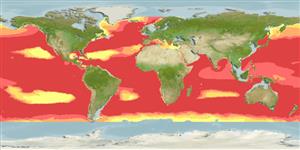Teleostei (teleosts) >
Stomiiformes (Lightfishes and dragonfishes) >
Stomiidae (Barbeled dragonfishes) > Chauliodontinae
Etymology: Chauliodus: Greek, chaulios, chaulos, chaunos = to be with the mouth opened + Greek, odous = teeth (Ref. 45335).
More on authors: Bloch & Schneider.
Environment: milieu / climate zone / depth range / distribution range
Ecology
Marine; bathypelagic; depth range 200 - 4700 m (Ref. 74511), usually 494 - 1000 m (Ref. 28981). Deep-water; 70°N - 56°S, 180°W - 180°E
Warm and temperate parts of all oceans but with several distributional gaps in the southern central Atlantic, northern Indian Ocean, eastern Pacific north of the equator, etc. Also found in the western Mediterranean (Ref. 4759). South China Sea and East China Sea (Ref.74511).
Size / Weight / Age
Maturity: Lm ? range ? - ? cm
Max length : 35.0 cm SL male/unsexed; (Ref. 559)
Inhabits deep oceanic waters to more than 1,000 m depth; may migrate to near-surface waters at night (Ref. 4759). Up to depth of 1800 m (Ref. 47377). Depth range 473-1192 m in the eastern Ionian Sea (Ref. 56504). Meso- and bathypelagic from near the surface to 2800 m (Ref. 58302). Oviparous (Ref. 5951). Feeds on midwater fishes and crustaceans (Ref. 4759); mainly on myctophids (Ref. 5951). Lipid content is 2.4 % in fresh body weight and wax ester is 7.2 % in total lipids (Ref. 9193). Minimum depth from Ref. 58018.
Life cycle and mating behavior
Maturities | Reproduction | Spawnings | Egg(s) | Fecundities | Larvae
Gibbs, R.H. Jr., 1984. Chauliodontidae. p. 336-337. In P.J.P. Whitehead, M.-L. Bauchot, J.-C. Hureau, J. Nielsen and E. Tortonese (eds.) Fishes of the north-eastern Atlantic and the Mediterranean. UNESCO, Paris. Vol. 1. (Ref. 4759)
IUCN Red List Status (Ref. 130435)
Threat to humans
Harmless
Human uses
Tools
Special reports
Download XML
Internet sources
Estimates based on models
Preferred temperature (Ref.
123201): 2.8 - 11.4, mean 6.4 °C (based on 1838 cells).
Phylogenetic diversity index (Ref.
82804): PD
50 = 0.5020 [Uniqueness, from 0.5 = low to 2.0 = high].
Bayesian length-weight: a=0.00117 (0.00089 - 0.00155), b=3.12 (3.04 - 3.20), in cm total length, based on LWR estimates for this species (Ref.
93245).
Trophic level (Ref.
69278): 4.2 ±0.7 se; based on diet studies.
Resilience (Ref.
120179): Medium, minimum population doubling time 1.4 - 4.4 years (Preliminary K or Fecundity.).
Fishing Vulnerability (Ref.
59153): Low to moderate vulnerability (33 of 100).
Nutrients (Ref.
124155): Calcium = 15.9 [4.0, 64.8] mg/100g; Iron = 0.365 [0.113, 1.146] mg/100g; Protein = 2.93 [0.00, 6.84] %; Omega3 = 0.19 [0.06, 0.64] g/100g; Selenium = 13.4 [4.1, 54.1] μg/100g; VitaminA = 45.3 [5.7, 367.3] μg/100g; Zinc = 0.44 [0.20, 1.07] mg/100g (wet weight);
